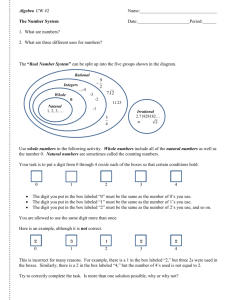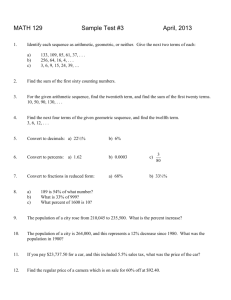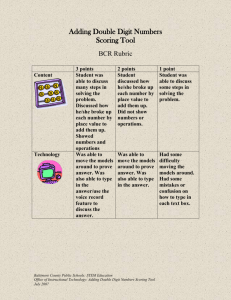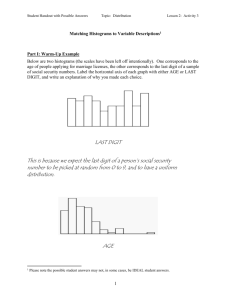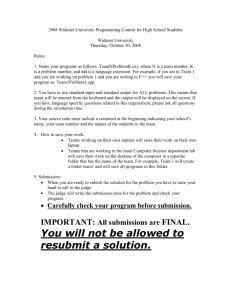Unit 1 - The Dudley Grid For Learning
advertisement
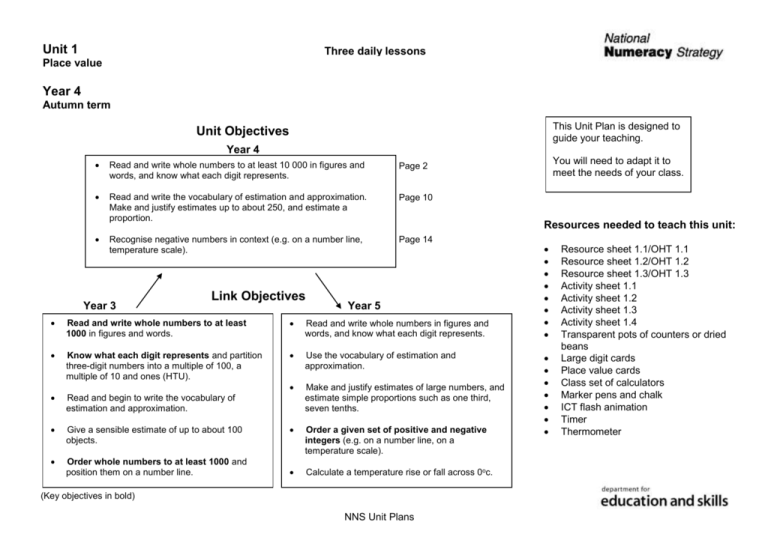
Unit 1 Three daily lessons Place value Year 4 Autumn term This Unit Plan is designed to guide your teaching. Unit Objectives Year 4 Read and write whole numbers to at least 10 000 in figures and words, and know what each digit represents. Page 2 Read and write the vocabulary of estimation and approximation. Make and justify estimates up to about 250, and estimate a proportion. Page 10 Recognise negative numbers in context (e.g. on a number line, temperature scale). Page 14 Year 3 Link Objectives You will need to adapt it to meet the needs of your class. Resources needed to teach this unit: Year 5 Read and write whole numbers to at least 1000 in figures and words. Read and write whole numbers in figures and words, and know what each digit represents. Know what each digit represents and partition three-digit numbers into a multiple of 100, a multiple of 10 and ones (HTU). Use the vocabulary of estimation and approximation. Read and begin to write the vocabulary of estimation and approximation. Make and justify estimates of large numbers, and estimate simple proportions such as one third, seven tenths. Give a sensible estimate of up to about 100 objects. Order a given set of positive and negative integers (e.g. on a number line, on a temperature scale). Order whole numbers to at least 1000 and position them on a number line. Calculate a temperature rise or fall across 0oc. (Key objectives in bold) NNS Unit Plans Resource sheet 1.1/OHT 1.1 Resource sheet 1.2/OHT 1.2 Resource sheet 1.3/OHT 1.3 Activity sheet 1.1 Activity sheet 1.2 Activity sheet 1.3 Activity sheet 1.4 Transparent pots of counters or dried beans Large digit cards Place value cards Class set of calculators Marker pens and chalk ICT flash animation Timer Thermometer Planning sheet Oral and Mental Objectives and Vocabulary Read and write whole numbers to at least 10 000 in figures and words, and know that each digit represents. Day One Partition into Th, H, T, U. Select four children and give each a large card with a digit written on it. Ask the children to arrange themselves into the largest number, then the smallest number. Ask the class questions such as: Objectives and Vocabulary Plenary Teaching Activities Read and write whole numbers to at least 10 000 in figures and words and know what each digit represents. Give out copies of Resource sheet 1.1/OHT 1.1 and display on an OHP or as a large chart on the board. Teaching Activities/ Focus Questions Tell the children you have a four-digit number in your head. You are going to give them clues to help them to guess it quickly. Give clues such as ‘it is 1000 more than 4692’ or ‘it is 100 less than 5792’. Get some children to think of a number and give the class clues. HOMEWORK – Give out Activity sheet 1.1 and explain how the children are to complete it. Ask questions such as: Q What do you notice about the numbers? Q What is the number they have made? Begin to add/subtract 1, 10, 100, or 1000. Ask the children to write the number 7585 in the air in front of them and keep it in their heads. Ask the class questions such as: Q What other numbers could you make using the four digits? Q What is the largest/smallest number you can see? Use place value cards to make a fourdigit number such as 5243. Show the number to the children and get them to read it aloud. Change the number e.g. to 5143. Ask the class: Q What number is this? VOCABULARY one-digit, two-digit, threedigit and four-digit numbers place value partition 1000 more/less than Q Is it a larger or smaller number? RESOURCES Resource sheet 1.1/OHT 1.1 Place value cards Marker pens or chalk Activity sheet 1.1 Digit cards 0-9 Q What is the value of the digit that was changed? Show 5243 again and change another digit. Repeat the activity with other digit numbers. Q What patterns can you see? Write some four-digit numbers on the board. Tell children they are to write each four-digit number in their books, partition it using Resource sheet 1.1 and then write the number in words. Work through an example. Explain that when they have finished they should read their numbers to their partner. Q If you swap these digits around, what numbers can you see? Q Are the numbers arranged in a special way? Point to 9000, 400, 60, 5 on the chart and get children to read them aloud – nine thousand, four hundred, sixty, five. With place value cards make the number 9465 and get children to read the number aloud. Use the cards to check that children can partition the number and say what each digit represents. Show the class how to write the number in words. Repeat using other numbers from the grid. Q Which is the units digit, the thousands digit? RESOURCES Large digit cards Place value cards Year Group: 4 Partition into Th, H, T, U. Q Is this the largest, smallest number they can make? Why? Which digit helps you to decide? VOCABULARY units, tens, hundreds, thousands digit Term: Autumn Main Teaching Teaching Activities Unit 1 Place value By the end of the lesson children should be able to Write four-digit numbers in figures and words; Review the children’s work and correct any misinterpretations. Show the class four one-digit cards 4, 8, 1 and 9. Give each of four children a market pen or chalk and get them to write on the board and say aloud a four-digit number they can make from these numbers. Partition numbers into thousands, hundreds, tens and units and know what each digit in a four-digit number represents; The class checks that these are said correct before four more children come to the board. Using the numbers on the board, ask the children: Identify numbers 1000, 100, 10 and 1 more and less. Q Which number is largest/smallest? Q Which numbers have the most hundreds? Using 0-9 digit cards ask the children to choose four digits and make largest/smallest numbers. Establish for largest number the largest digit is to go in the thousands column etc. NNS Unit Plans (Refer to supplement of examples, section 6, page 2, 4.) Planning sheet Oral and Mental Objectives and Vocabulary Use the vocabulary of estimation and approximation. Day Two Unit 1 Place value Make and justify estimates of large numbers. Ask the children to close their eyes and imagine starting at 900 and walking half way along a line towards 1000. What number will they be standing on? Repeat using different intervals. 900 Plenary Objectives and Vocabulary On the board or OHP draw a line such as: Read and write the vocabulary of estimation and approximation. Teaching Activities Review the children’s homework. Remind them that they were using large numbers. Ask them to estimate the number of times they breathe each day or how many bricks there are in the school building. Explain that these are large numbers; they are now going to estimate smaller numbers. Make and justify estimates up to about 250 and estimate a proportion. 1000 Place an arrow at a point on the number line; in pairs get children to estimate the number marked by an arrow. Ask children to explain their strategies. Emphasise strategies such as identifying the midpoint, and splitting the interval up into steps. Q Were your estimates too big or too small? Draw up a list of successful strategies the children used. Repeat with different number lines, decreasing and increasing the range. For example Give groups of children a transparent pot of counters or dried beans. Ask children whether they can use the same strategies for estimating the triangles to estimate the counters/beans. Discuss alternative strategies and get children to estimate and share these with their group. Discuss the range of estimates and their methods. Ask the class: Q What strategies worked best? 6000 VOCABULARY estimate guess approximate Q How can we get better at estimating? 8000 Emphasise the language of approximation and summarise the children’s strategies such as: identifying the midpoint value, using steps and multiples of 10 and 100 to inform their estimates. Q What estimates do we accept? Q Which estimates are sensible? Why? VOCABULARY estimate, approximate predict, nearest proportion RESOURCES Timer Transparent pots of counters or dried beans Activity sheet 1.2 Activity sheet 1.3 Teaching Activities/ Focus Questions Ask the children to predict how many triangles they could draw in 1 minute using a pencil and ruler. Time 1 minute while the children draw their triangles. With a partner, think of 2 different ways of estimating the number of triangles on the page. Check that children understand how to use strategies such as how many in a row and how many rows, how many in half or quarter of the page, to help them to arrive at an estimate. Get children to test one of their methods on their partner’s drawing and see how close they were to the real number of triangles. Ask: Q How did your results match your predictions? Year Group: 4 Main Teaching Teaching Activities Term: Autumn Give out the Activity sheet 1.2. Remind children to think carefully about how they can make suitable approximation in order to estimate. Take feedback reinforcing appropriate strategies. Some possible strategies might be: Counting dots in a quarter of the rectangle and multiplying by 4. Counting along the top (approximately 5 dots) and counting as in the side (approximately 10) and multiplying them. Grouping in approximate groups of 10. Children to use these strategies when estimating on Activity sheet 1.3. Q Which were easiest to estimate? Why? NNS Unit Plans Show the children a jar of counters or beans approximately half full. Tell them when full the jar held 100. Ask: Q How many are left? What proportion is this? Q What if the jar held 50 when full? Repeat with the jar about one-third full, one-fifth full etc. Collect the children’s estimates and discuss their methods. Summarise key skills of estimation and approximation. By the end of the lesson children should know how to: Estimate and explain the position of a point on a number line; Select and explain strategies for estimating up to 250 objects; Estimate and explain a simple proportion e.g. the proportion of sweets left in a pot. (Refer to supplement of examples, section 6, page 10.) Planning sheet Oral and Mental Objectives and Vocabulary Count back in repeated steps of 10. Day Three Count back in 1s through zero. Term: Autumn Write some three-digit starter numbers on the board, e.g. 163, 185, 504, 309. Start with 163, get the class to count back in 10s to 3. Ask the children if they were to count back in 10s from the other starter numbers, how close will they get to 0. Check for 185. Ask whether they can give other three-digit starting numbers that will get closer to 0 and why. Plenary Objectives and Vocabulary Teaching Activities Recognise negative numbers in context (e.g. on a number line, on a temperature scale). Remind children of the human number line from –3 to 3 and say that this line can be extended in both directions, one way for negative numbers and the other way for positive numbers. These numbers are called the integers. Cut Activity sheet 1.4 into sets of cards. Give the children the cards with integers –15 to 5 written on them, and in pairs arrange them in order. Ask children to point to –5 and the other to point to 3. Ask class to read the integers within that range. Give practice using different ranges such as –8 to 1, –3 to 5. Get the children to shuffle the cards and take 10 cards from the pack. Arrange these cards in order. Place the remaining cards face down. In turn, the children take a card and put it in the correct position with the rest. Repeat with the children taking only 6 cards from the pack at the start of the game. Ask the class: Q How can we count back through 0? Use a number line to illustrate counting back from 10 through zero to –10. Encourage children to count back as you mark the numbers on the number line using the vocabulary negative one etc. Shuffle cards with integers 3 to –3 on them and invite 7 children to come to the front and arrange themselves in order. Get the class to count from the 3 back to –3 and forwards. With the whole class, use the number line to practise counting forwards and backwards in 1s and 2s. Q What number is after 5, 0, -3? Q What number lies between –5 and –3? VOCABULARY number line, zero, negative one, negative two… RESOURCES Make cards with integers –3 to 3 Show the class the Winter Weather OHT 1.3. Ask children to discuss in pairs what temperatures the four arrows are pointing to. Take feedback, and discuss the strategies used. Check understanding by asking: Q Can you tell me two temperatures between 0oC, and –10oC? Which is the closer to 0oC? By the end of the lesson children should be able to Q Tell me a number that goes between these two integers? Count back through zero; Ask the children to close their eyes and visualise number line from –5 to 5. Ask: Q What number is before 5, 0, -3? Teaching Activities/ Focus Questions Extend the activity asking pairs to shuffle chards and remove 5 or more cards, put the remaining cards in order. They are to identify the missing integers before they look at the cards. Ask: Q What did you look for first when ordering the cards? Year Group: 4 Main Teaching Teaching Activities Unit 1 Place value Explain that negative numbers are used to tell the temperature and appear on a thermometer. Remind the class that 0oC denotes the freezing point of water. Using OHT 1.2 or display, show the class a thermometer. Point to a temperature on the thermometer and ask:: Recognise and order negative numbers in the context of a number line or a temperature scale. Q What temperature does the thermometer show? VOCABULARY integer positive negative above zero below zero Remind children that temperatures are said to be above and below zero. Show examples of this on the thermometer using ICT flash animation ‘Thermometer’ as a teaching tool. Give the children practice saying and recording temperatures –3oC, -7oC, 0oC. Ask children to choose two temperatures above and below given temperatures for example zero and –5oC on the thermometer. RESOURCES Activity sheet 1.4 OHT 1.2 OHT 1.3 ICT flash animation ‘Thermometer’ NNS Unit Plans (Refer to supplement of examples, section 6, page 14.)

